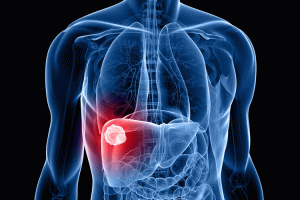
Fibrolamellar carcinoma (FLC) is a rare liver cancer with a poor prognosis if not addressed early with surgery.
The disease is caused by a single genetic mutation that creates a fusion protein.
Scientists at St. Jude Children’s Research Hospital and The University of Tennessee Health Science Center discovered an immune cell protein that can target and spark the destruction of FLC.
Scientists found naturally occurring T cells in a patient with FLC were uniquely capable of recognising the fusion protein.
These cells provide a basis for developing a novel immunotherapy treatment approach for FLC. The findings were published today in Cell Reports Medicine.
Fusion proteins result from DNA damage that joins together two different genes.
Sometimes, the hybrid gene produces a fusion protein that helps cells become cancerous.
All FLC tumours are driven by the fusion of the genes DNAJB1 and PRKACA, occurring at the same place in the genome in more than 90% of FLC patients.
Since this fusion protein does not exist in normal cells, the immune system should be able to find it and destroy the cancer cells harbouring the fusion. However, this concept relies on T cells recognising the fusion protein and responding to it.
The St. Jude–UTHSC team found two rare T cells that can do just that. This discovery shows a proof-of-concept for a novel treatment approach.
“We used a patient’s T-cell receptor that led T cells to kill the tumour cells with the fusion protein,” Allison Kirk, St. Jude Graduate School of Biomedical Sciences. “This approach worked very well in a mouse model.”
A new treatment approach for FLC
T cells are a type of white blood cell that finds and kills infected or cancerous cells in the body.
These immune cells find their targets using the T-cell receptor, which guides the cells to one specific protein on a tumour, akin to law enforcement using facial recognition to find a criminal.
The FLC-causing fusion protein represents a dangerous fugitive in the body that is difficult to identify.
In 60-80% of cases, an FLC tumour cannot be surgically removed, and even after treatment, the disease relapses, with patients succumbing within 10 years.
Outside of surgery, no effective therapies exist, motivating scientists to find a new approach.
When the scientists put a T-cell receptor that recognised the fusion protein into millions of T cells in mice with FLC-like tumours, they noted a significant reduction in tumour size and all cancer cells expressing the fusion protein were eliminated.
In essence, the researchers flooded the tumour with immune “law enforcement,” which was prepped with the knowledge of who to look for: the fusion protein.
In humans, a similar approach, called T-cell receptor-transgenic (TCR-T) immunotherapy, would take a patient’s own T cells and add the fusion protein-specific T-cell receptor.
The modified T cells are then returned to the patient, where they can seek out and destroy the tumour.
Finding a way to increase anti-fusion protein immunity
The study also confirms that it is possible to mount a natural immune response to the fusion protein, even if it is rare. In fact, the scientists only found two natural T-cell responses to the fusion.
Confronted with that rarity, the researchers attempted to extrapolate from the two receptors to understand what others might look like.
“Once we’ve seen a few examples of a T-cell receptor that sees an antigen, we can usually predict others,” said senior co-corresponding author Paul Thomas, PhD, St. Jude Department of Host-Microbe Interactions.
“We found these two receptors didn’t look anything like each other or anything else we saw in the patient. So, they were both unique.”
Such rare results indicate it is unlikely that scientists will find another natural response to a preexisting tumour.
“We tested many other patients and only ever found two T-cell responses, both from a single patient,” Thomas said.
“This is an incredibly rare response, so we were very lucky to find it.”
It remains unclear what the most effective treatment for FLC will be, but finding this single individual whose T cells can respond to the fusion has opened new opportunities.
“In the end, we only found one patient with immune responses to the FLC fusion protein,” Thomas said.
“But one may be just enough to push us forward into the next phase of developing more effective treatments for FLC.”
The World Cancer Declaration recognises that to make major reductions in premature deaths, innovative education and training opportunities for healthcare workers in all disciplines of cancer control need to improve significantly.
ecancer plays a critical part in improving access to education for medical professionals.
Every day we help doctors, nurses, patients and their advocates to further their knowledge and improve the quality of care. Please make a donation to support our ongoing work.
Thank you for your support.